Mary Ellen Scott
22 May 1849 – 11 December 1935
The first winter of 1847 in the Salt Lake Valley was mild but the
residents of the Old Fort suffered many discomforts. During March and
April of 1848 heavy spring snow and rain descended on the valley,
During the spring provisions became scare. Many were without shoes or
adequate clothing. A late spring frost damaged the crops and gardens
followed by a drought in May and June.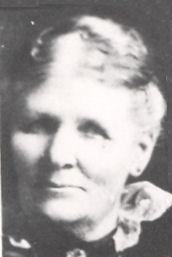
By the end of September 1848 nearly three thousand Mormon pioneers, representing about one fourth of the exiles from Nauvoo had arrived in the territory. Of the hundreds of pioneers who arrived that fall were John Scott and his wives, Elizabeth with five children, Mary with one, and Sarah also with one child.
With the arrival of so many, new settlements were established in the valley. The Scotts settled on one hundred acres of land in Millcreek in the southeast corner of the valley. Mary Ellen Scott was born May 22, 1849 in Millcreek, Utah, the daughter of Mary Pugh and John Scott. Mary Pugh, met her husband in Nauvoo and there became his second wife; he was known as Colonel John Scott of the Nauvoo Legion and was a bodyguard of the Prophet Joseph Smith while in Nauvoo. Mary had washed and ironed temple clothes in the basement of the Nauvoo Temple.
Mary Ellen grew up in a pioneer home. In this home lived her
father, his five wives, and thirty-six children. Mary Ellen's
girlhood was spent at home where she learned to cook, sew, spin,
weave, and tend babies. Her mother who had received an education in
England became the first teacher of the Scott School which was
established John Scott for his children and others in Millcreek.

Mary Pugh Scott
One day at school, one of Mary Ellen's brothers sneaked a hornets nest into the school. He asked her to hold the cone shaped thing, while he covered it with his hat so the teacher could not see it. As soon as Mary took it, he hit it with his hat and gave a loud shout and pandemonium broke loose. The children were severely stung, poor Mary Ellen was stung the worst of any of them. The boy got several lashings with a willow.
Times were so hard. Grasshoppers had destroyed nearly everything growing and money was so scarce. Her father was called to go on his second mission to Great Britain in 1855.
The family dug roots and sego bulbs and anything to help out with food. When Mary was six years old, she and her sister went out each day to pull flax. Her mother wrapped their little hands in rags so the flax would not cut their hands. Mary earned three dollars and was so happy because there was enough money to buy her first new dress. All her life she had to wear hand-me-downs cut smaller to fit her.
Her mother told her that there were three babies in the home and no food to feed them and asked her if she could take her money and walk into Salt Lake thirty three long blocks and buy flour. Kind hearted Mary loved babies so much and could not see them suffer, so thoughtful Mary told me to use her money.
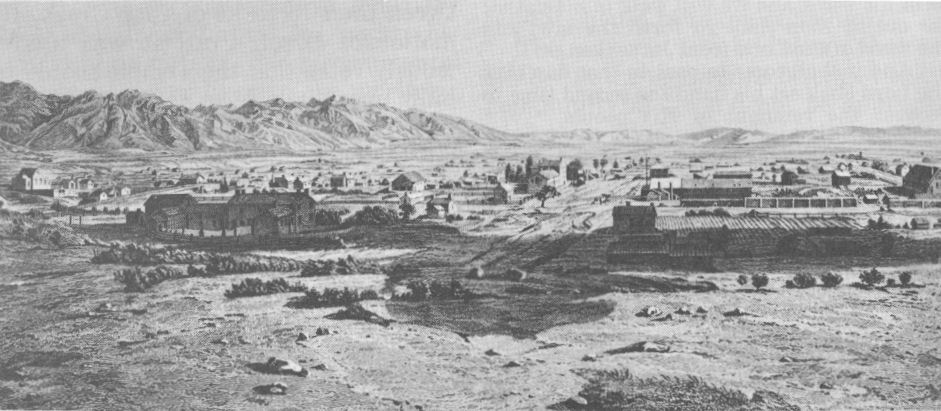
A sketch of Salt Lake City in the early days.
In 1857 Johnston's Army was sent to Utah to subdue the Mormons. During the winter of 1857-58 the Saints were ordered to leave Salt Lake City and move south because of the coming of Johnston's Army. Accordingly, Brigham Young directed all of the people north of Utah County to leave their homes and proceed southward, Thus began the "move". During the spring of 1858 thirty thousand people migrated southward. The Scott family had to pack up their belongings into the wagons and started south. It was so hard to leave their home.
One day they paused to let the tired oxen rest and six year old Mary Ellen wandered away picking flowers alone, a dangerous thing to do on account of the Indians. A group went to find her and Brigham Young's young negro servant found her and said, “Don't you cry Honey, I'll take you to your Mama.” Mary said, “Don't you put your dirty hands on me!” and she was spanked good for her outburst. Being away from home they were destitute for food and clothing. Brigham Young sent word to John to come home as quickly as he could. He arrived January 19, 1858. When the crisis was passed they were able to return to their homes.
When Mary Ellen was fourteen, she began dating a young Englishman by the name of Peter Sheffield Barson. An entry in her diary said, "A young black-haired Englishman walked all the way from Salt Lake City out to Millcreek to be with me at Sunday School. He ate dinner with our family and also stayed for meeting."
Mary Ellen's father was a polygamist and at the same dinner table was Rebecca, the sixteen-year-old daughter of another mother, who promptly set her cap for Peter. Mary Ellen was torn. Rebecca had always been her favorite sister. They had tended babies together, milked the cows, and pulled flax until their hands were cut and bleeding from the sharp blades. Now that they were sixteen, they practiced the promenade, balancing apples on their heads to develop grace and smoothness. Mary Ellen knew there would never be a sister quite like Rebecca. But her heart also told her that Peter was the one for her.
On Peter's next call, he walked up the lane toward the Scott home as the little children called out, "Here comes the city slicker, here comes the city slicker." Rebecca, who loved practical jokes, saw him near the log across Millcreek and untied their feisty ram. The ram promptly braced himself at the other end of the log and eyed Peter with a wicked gleam. Peter felt a little nervous but could not back down or "coward" would join "city slicker." He cautiously moved along the log. The children were laughing as they looked on. He stretched out his hand toward the ram and made soothing noises as he took another step. The ram stood still. He felt a little braver and took two more steps, never taking his eyes from the animal.
"Watch out, Pete," the children yelled. The ram lunged forward, head down, and bunted sending Peter sprawling into the creek. He dragged himself onto the bank feeling sheepish in every sense of the word. The children were still laughing as Rebecca, with profuse apologies, found him some of Ephraim's clothes and offered to hang his wet ones to dry. Peter managed to hold his temper exceptionally well, but he would have liked to slap all the kids and shake Rebecca.
Rebecca was charming for the rest of his visit; but on his next visit, Peter brought two homemade rings for Mary Ellen. One had been made from the back of an old comb that he had melted and shaped to fit her finger and the other from a large broken hair pin he had found. Each had been polished with meticulous care, and he could not hide his pride as he presented them to his sweetheart. Rebecca understood the message and silently wept. The evening passed quickly and Mary Ellen noticed Rebecca's red eyes as John Scott called his family and four young men visiting various daughters together for their evening prayer. She was proud and happy to have Peter kneel by her side in prayer, but her kind heart ached for Rebecca.
Father Scott, the autocrat, called upon another suitor present to offer
prayer, and Peter secretly enjoyed the young man's embarrassment as
he stumbled through a prayer. Suddenly he thought, what if his turn
was next? That wouldn't be so funny. He resolved to memorize a
righteous sounding prayer, one that would impress John Scott.
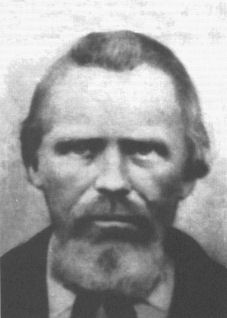
John Scott
John Scott announced sternly, "The doors of my house will be locked at nine o'clock." The four visiting suitors looked at the clock, quickly found their hats, shook hands with the entire family, and departed.
Thanksgiving time came, and Cousin Hannah came from Provo to spend a few days at the Scott home. Hannah was pretty, skilled in feminine wiles, and amused by taking a beau away from any girl. The trusting Mary Ellen didn't sense her danger. She recorded in her diary, "I made me a pair of shoes to go to the Thanksgiving dance with Peter." But she danced little; Hannah monopolized Peter who was flattered by the glamorous cousin's attention and responded with wit and fun. Mary Ellen sat sadly on the bench, watching Hannah bring out the best in him. The dance finally ended and Peter accompanied the girls to the Scott home. Hannah gloated, while Mary Ellen sat silent and drooping, and Rebecca felt unspoken sympathy.
Aunt Sarah Ellen, the third wife, seeing Mary Ellen's suffering said, "Fight for him, you ninny. I'll do your chores anytime you want to go courtin', and you can wear my white petticoat with the embroidered ruffle." Mary Ellen made no response. Seeing that this offer didn't work, Aunt Sarah Ellen opened the lid of a wooden box that had been neatly covered with a brown calico print and extracted a length of bright green paisley. "See," she said, "this is a piece of goods my brother brought me from California. I will make a dress for you. I'll make it with puffed sleeves and a bustle and..." The smile she had been waiting for came. "Now go and get your man."
With this encouragement and the confidence brought by a pretty dress, Mary Ellen caught her beau, and she wrote next in her diary, "I am engaged to be married." Her trousseau was simple. She earned enough money for two factory nightgowns. Her brother Hyrum shot hawks for her, and she picked enough soft feathers from them to make a feather bed.
Peter had saved three hundred dollars. He worked for Wells Fargo, changing horses as the fast stagecoaches came through. With no parents or home, he decided to give his money to Mary Ellen for safekeeping. Several days later, he thought, "Suppose Mary Ellen should run off with some other man. What then would become of my money?" The thought of losing that money worked on Peter's mind for several days; until, in desperation, he walked to Millcreek and asked Mary Ellen to give back his money. She was hurt, but did as he asked. A few days later, Peter was sent north with freight to Corinne, then a "gentile" city, notorious for its gambling.
A reckless surge swept over him and he was caught up in the persuasions of a friendly stranger. When the evening was over, Peter counted his money. He had thirty dollars left. Shame and humiliation crept over him. How could he get married now, and what would Mary Ellen think of such a fool? He walked out alone along the banks of Bear River, sat down, took out his red handkerchief, and wept bitter tears of self-condemnation.
After returning to Salt Lake City, he walked again to Millcreek and told Mary Ellen his story. The loyal girl told him that she loved him just as much with thirty dollars as with three hundred, and they would be married just as they had planned.
Peter asked the consent of Mother Scott to marry her daughter, but John Scott was not at home. It would not do to marry without his consent, so Peter sent a telegram. John Scott replied, "I will give my approval if first you get the consent of Brigham Young." John Scott was an absolute monarch in his own home, and Peter knew he would have to see Brigham Young. A few days later, Peter, decked out in his Sunday best, knocked at the office door of the president at the time of his appointment. He explained the purpose of his visit. President Young smiled as he said, "You are ready to get married? Well, go my boy, and may God bless you." He took a gold-colored pencil from his pocket and wrote on a piece of paper. "I give my consent to this marriage. Brigham Young." The interview that Peter dreaded so much turned out to be a pleasant one.
They were married on October 20, 1869 in the Endowment House in Salt Lake
City. This young couple was poor, but got along very well as
Peter was ambitious, a fast worker at any job, and was often rewarded
with promotions. At first they
made their home in Salt Lake City where their first child, John
Samuel, was born premature on May 14, 1870. He only lived a couple of
months and died on July 28th.
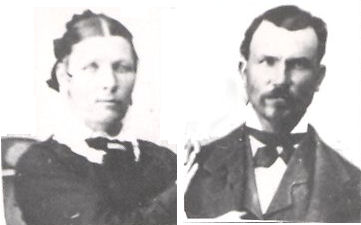
Mary Ellen Scott and Peter S. Barson about the
time they were married.
Over the next few years, Peter and Mary Ellen moved several times. After little John Samuel died, they moved to Millville, just south of Logan in Cache Valley. It was here that Hyrum Sheffield was born on August 27, 1871. They next moved back to the Salt Lake Valley to Millcreek near Mary Ellen's family. Mary Eliza,who went by Liza was born on January 10, 1873.
Plural marriage was being practiced at the time and obedient to the
teachings of the Church, Peter and Eliza Ann Scott were married on
August 8, 1875 in the Endowment House by Joseph F. Smith. Eliza Ann
was Mary Ellen's younger sister, also the daughter of John and Mary
Pugh Scott. Eliza was born on October 20, 1852 in Millcreek.
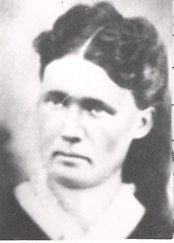
Eliza Ann Scott
Peter, Mary Ellen, Eliza, and their family next moved back into Salt Lake City where they lived in a one room house. Later they moved to Slaterville in Weber County. It was here that Eliza's first child, Denny Burdell who went by “Bird” was born on May 11, 1876.
In the fall of 1876 Peter moved his family to Clarkston in Cache Valley. When they moved to Cache Valley, Mary Ellen walked in front of the oxen and coaxed them up the divide with ears of corn. The roads were bad and the load was heavy, but as she said, "They got here just the same." At the time, Clarkston was still a fledgling settlement and the homes were either log cabins or dugouts. Their first home in Clarkston was a log house with a fireplace used for cooking and heat. Homemade candles were used for lighting. Mary Ellen and Eliza made their clothing from home spun fabric.
In some plural marriages the wives lived in separate homes with their own children. In the case of the Barsons, they all lived under the same roof. Mary Ellen and Eliza, being sisters had a loving relationship with each other and the husband who they shared. Their children all got along well with each other. All in all, they were a very close knit family. Two more children were born to Eliza. Lucy Ellen who went by Nell was born on August 20, 1879 and Vilate Scott who went by Vie was born on January 29, 1882.
The comforts of modern living were appreciated by Peter who, with his two wives, welcomed improvements as they came along. They had moved several times and bettered their conditions each time. He became one of the more prosperous farmers in Clarkston. To them the possession of land was a means of security, and land was something almost sacred. Seeing the possibilities in little things, they were anxious to succeed and were not afraid of hard work.
Thus it was that in 1887 Peter acquired 160 acres of land located one and
one-half miles east and a little north of Clarkston where they built
a new two story frame house and he carefully laid out a well-planned
farm. The Barsons had a few cows and made butter which they sent to
Salt Lake for Grandma Scott to sell. From the proceeds they were able
to buy wallpaper for their home. 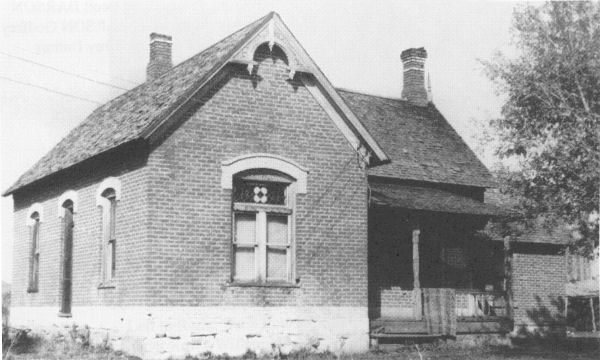
The Barson home
On August 28, 1887 Mary Ellen's fourth child, Martha Jane was born. She went by Mattie. Then one Friday night in September Eliza Ann, who had always been in poor health, had been ironing sheets when she suddenly became very ill. Early in the morning of the following Sunday, she died at the age of thirty six on September 25, 1887. The family was grief stricken. Forty eight wagons accompanied her remains to the cemetery with a white top buggy serving as the hearse and another one for the immediate family to ride in.
With the loss of her sister, Mary Ellen raised Eliza Ann's three children ages eleven, eight, and five as if they were her own. Many people in Clarkston couldn't tell which children were which as Mary Ellen showed very little preference, if any. Mary Ellen said many times that Eliza's children where a comfort and blessing to her and that she was proud to have them call her "Mother."
Mary Ellen's family was compete with the birth of her last child, Bessie Cloe, who was born on May 29, 1890. By this time the older children were getting older. On June 10, 1897 Liza married Joseph Maurice Godfrey. Then six months later Hyrum married Effie Bell on December 22nd. And the following spring, Nell married Thomas Henry Godfrey on March 23, 1898.
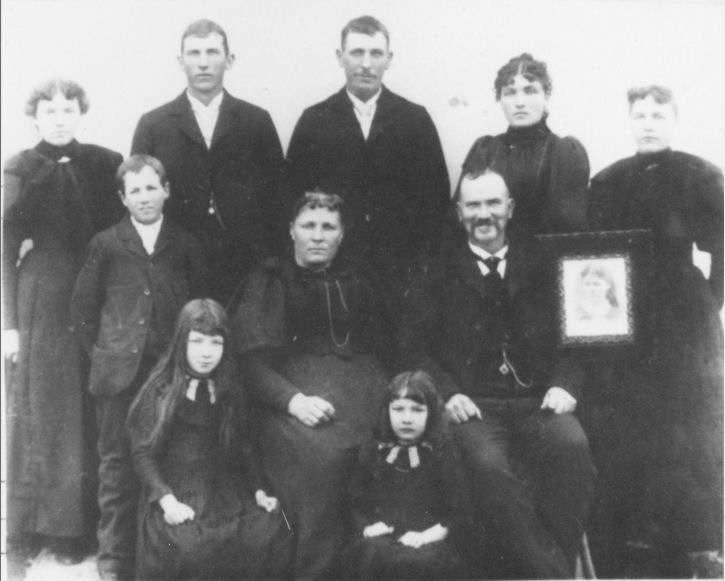
The Barson Family in 1896. Back row; Ellen, Bird, Hyrum, Liza, and Vie. Center: William,
Mary Ellen, Peter S. Barson, a portrait of Eliza Ann. Front: Mattie and Bessie.
On the heals of the weddings came the arrival of grandchildren the first being Liza's daughter, Mary Eliza Godfrey, who arrived on April 13, 1898. In the matriarchal line it was tradition to name the first daughter Mary. Therefore Mary Eliza Godfrey was one in a long line of Marys being the daughter of Mary Eliza Barson, who was the daughter of Mary Ellen Scott, who was the daughter of Mary Pugh, who was the daughter of Mary Bailey, who was the daughter of Mary Mason, who was the daughter of Mary Phillips.

Four gernations of Marys:
Mary Ellen
Scott, Mary Eliza
Godfrey, Mary Eliza Barson,
and Mary Pugh
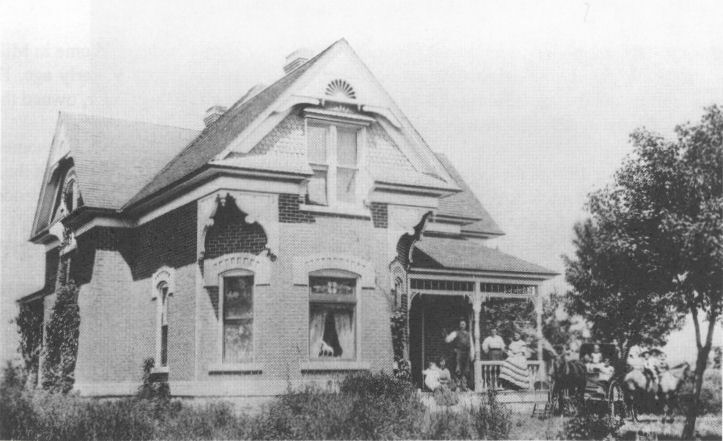
The home built in 1899. Peter and Mary Ellen are standing on the porch. Notice the
young woman in the ruffle skirt sitting on the rail. Another young woman is sitting on
the steps with a small cild. Three children are in carriage and two more on the horse.
In 1899 a new red brick house was built next to the two story frame
house. Three more weddings took place during the first decade of the
new century. On January 7, 1904 Bird married Anna Elizabeth
Rasmussen. On February 27, 1906 Vie married Willard Richard Dahle.
And on December 5, 1906 Mattie married Thomas Arthur Goody.
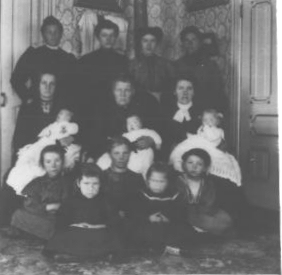
The Barson women in 1907: Back row:
Liza, Bessie, Mattie, and Nell. Middle
row ; Ann, Mary Ellen, and Vie (The
babies are not identified). Seated on the
floor: Ann Godfrey, Emily Godfrey, Mary
(in the center), Sylvia, and LaRee Barson
For many years Peter served as justice of the peace. On April 23, 1912 he performed the marriage of their last daughter, Bessie, to Phillip Hyrum Rasmussen.
For twenty years, Mary Ellen served as the Second Counselor in the Relief Society Presidency in the Clarkston Ward from 1902 to 1922. She considered this service a privilege and a pleasure.
Mary Ellen enjoyed doing handwork and spent many hours netting doilies and wide edges for pillow cases. She made and gave everyone of her granddaughters a pair of pillow cases with beautiful wide drawnwork and wide netted lace on the bottom.
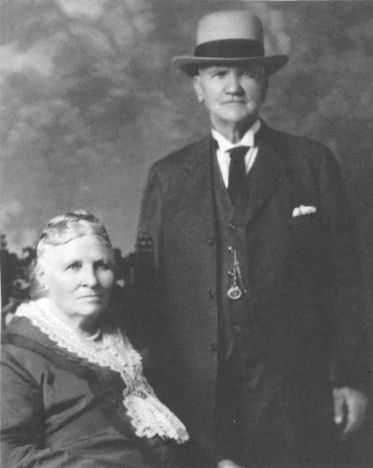
Mary Ellen and Peter S. Barson in later years
Peter and Mary Ellen made three trips to Joplin, Missouri to visit Peter's
only brother, Dr. John W. Barson, and family. They made one trip to
California to visit Mary Ellen's sister, Vilate S. Hilton. Many
relatives and friends were made welcome in their home.
Mary Ellen Scott Barson died of bronchial pneumonia at her home in Clarkston, Utah at three forty five in the afternoon on December 11, 1935 at the age of eight six and half. Her posterity included twenty one grandchildren. Peter lived another seven years and died on November 9, 1942.
The main source of this story comes from the Life Story of Mary Ellen
Scott Barson by Corinne Godfrey Heggie along with the writings of Ann
Godfrey Hansen. Other sources include the Life Story of Mary Ellen
Barson and the Life Story of Mary Pugh Scott, both by LaRee Barson McCaulley.
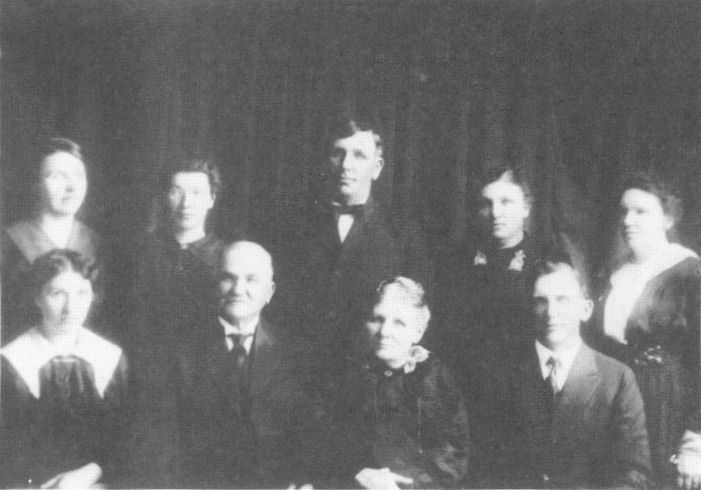 The Barson Family. Back row: Vie, Mattie, Hyrum, Liza, and Nell. Front row: Bessie,Peter, Mary Ellen, and Bird. |